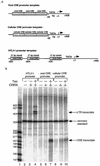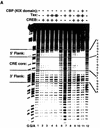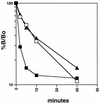Human T-cell leukemia virus type 1 Tax requires direct access to DNA for recruitment of CREB binding protein to the viral promoter
- PMID: 9447968
- PMCID: PMC108783
- DOI: 10.1128/MCB.18.2.721
Human T-cell leukemia virus type 1 Tax requires direct access to DNA for recruitment of CREB binding protein to the viral promoter
Abstract
Efficient human T-cell leukemia virus type 1 (HTLV-1) replication and viral gene expression are dependent upon the virally encoded oncoprotein Tax. To activate HTLV-1 transcription, Tax interacts with the cellular DNA binding protein cyclic AMP-responsive element binding protein (CREB) and recruits the coactivator CREB binding protein (CBP), forming a nucleoprotein complex on the three viral cyclic AMP-responsive elements (CREs) in the HTLV-1 promoter. Short stretches of dG-dC-rich (GC-rich) DNA, immediately flanking each of the viral CREs, are essential for Tax recruitment of CBP in vitro and Tax transactivation in vivo. Although the importance of the viral CRE-flanking sequences is well established, several studies have failed to identify an interaction between Tax and the DNA. The mechanistic role of the viral CRE-flanking sequences has therefore remained enigmatic. In this study, we used high resolution methidiumpropyl-EDTA iron(II) footprinting to show that Tax extended the CREB footprint into the GC-rich DNA flanking sequences of the viral CRE. The Tax-CREB footprint was enhanced but not extended by the KIX domain of CBP, suggesting that the coactivator increased the stability of the nucleoprotein complex. Conversely, the footprint pattern of CREB on a cellular CRE lacking GC-rich flanking sequences did not change in the presence of Tax or Tax plus KIX. The minor-groove DNA binding drug chromomycin A3 bound to the GC-rich flanking sequences and inhibited the association of Tax and the Tax-CBP complex without affecting CREB binding. Tax specifically cross-linked to the viral CRE in the 5'-flanking sequence, and this cross-link was blocked by chromomycin A3. Together, these data support a model where Tax interacts directly with both CREB and the minor-groove viral CRE-flanking sequences to form a high-affinity binding site for the recruitment of CBP to the HTLV-1 promoter.
Figures













Similar articles
-
Anchoring of CREB binding protein to the human T-cell leukemia virus type 1 promoter: a molecular mechanism of Tax transactivation.Mol Cell Biol. 1997 Sep;17(9):5156-64. doi: 10.1128/MCB.17.9.5156. Mol Cell Biol. 1997. PMID: 9271393 Free PMC article.
-
HTLV-1 21 bp repeat sequences facilitate stable association between Tax and CREB to increase CREB binding affinity.J Mol Biol. 1996 Nov 22;264(1):20-31. doi: 10.1006/jmbi.1996.0620. J Mol Biol. 1996. PMID: 8950264
-
Molecular interactions involved in the transactivation of the human T-cell leukemia virus type 1 promoter mediated by Tax and CREB-2 (ATF-4).Mol Cell Biol. 2000 May;20(10):3470-81. doi: 10.1128/MCB.20.10.3470-3481.2000. Mol Cell Biol. 2000. PMID: 10779337 Free PMC article.
-
Insight into the tumor suppressor function of CBP through the viral oncoprotein tax.Gene Expr. 2000;9(1-2):29-36. doi: 10.3727/000000001783992678. Gene Expr. 2000. PMID: 11097423 Free PMC article. Review.
-
The HTLV-1 Tax protein: revealing mechanisms of transcriptional activation through histone acetylation and nucleosome disassembly.Biochim Biophys Acta. 2010 Mar-Apr;1799(3-4):266-74. doi: 10.1016/j.bbagrm.2009.09.002. Epub 2009 Sep 25. Biochim Biophys Acta. 2010. PMID: 19782779 Review.
Cited by
-
Myocyte enhancer factor (MEF)-2 plays essential roles in T-cell transformation associated with HTLV-1 infection by stabilizing complex between Tax and CREB.Retrovirology. 2015 Feb 27;12:23. doi: 10.1186/s12977-015-0140-1. Retrovirology. 2015. PMID: 25809782 Free PMC article.
-
HTLV-1 Tax mutants that do not induce G1 arrest are disabled in activating the anaphase promoting complex.Retrovirology. 2007 May 29;4:35. doi: 10.1186/1742-4690-4-35. Retrovirology. 2007. PMID: 17535428 Free PMC article.
-
SR-related protein TAXREB803/SRL300 is an important cellular factor for the transactivational function of human T-cell lymphotropic virus type 1 Tax.J Virol. 2003 Sep;77(18):10015-27. doi: 10.1128/jvi.77.18.10015-10027.2003. J Virol. 2003. PMID: 12941912 Free PMC article.
-
Molecular Mechanisms of Neurodegenerative Diseases Induced by Human Retroviruses: A Review.Am J Infect Dis. 2009 Jul 1;5(3):231-258. doi: 10.3844/ajidsp.2009.231.258. Am J Infect Dis. 2009. PMID: 20352020 Free PMC article.
-
Molecular characterization of HTLV-1 Tax interaction with the KIX domain of CBP/p300.J Mol Biol. 2007 Sep 28;372(4):958-969. doi: 10.1016/j.jmb.2007.06.062. Epub 2007 Jun 29. J Mol Biol. 2007. PMID: 17707401 Free PMC article.
References
Publication types
MeSH terms
Substances
Grants and funding
LinkOut - more resources
Full Text Sources
Miscellaneous
